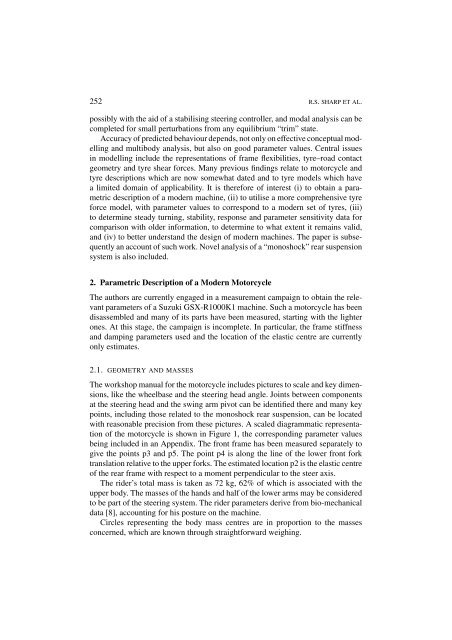Advances in the Modelling of Motorcycle Dynamics - ResearchGate
Advances in the Modelling of Motorcycle Dynamics - ResearchGate
Advances in the Modelling of Motorcycle Dynamics - ResearchGate
Create successful ePaper yourself
Turn your PDF publications into a flip-book with our unique Google optimized e-Paper software.
252 R.S. SHARP ET AL.possibly with <strong>the</strong> aid <strong>of</strong> a stabilis<strong>in</strong>g steer<strong>in</strong>g controller, and modal analysis can becompleted for small perturbations from any equilibrium “trim” state.Accuracy <strong>of</strong> predicted behaviour depends, not only on effective conceptual modell<strong>in</strong>gand multibody analysis, but also on good parameter values. Central issues<strong>in</strong> modell<strong>in</strong>g <strong>in</strong>clude <strong>the</strong> representations <strong>of</strong> frame flexibilities, tyre–road contactgeometry and tyre shear forces. Many previous f<strong>in</strong>d<strong>in</strong>gs relate to motorcycle andtyre descriptions which are now somewhat dated and to tyre models which havea limited doma<strong>in</strong> <strong>of</strong> applicability. It is <strong>the</strong>refore <strong>of</strong> <strong>in</strong>terest (i) to obta<strong>in</strong> a parametricdescription <strong>of</strong> a modern mach<strong>in</strong>e, (ii) to utilise a more comprehensive tyreforce model, with parameter values to correspond to a modern set <strong>of</strong> tyres, (iii)to determ<strong>in</strong>e steady turn<strong>in</strong>g, stability, response and parameter sensitivity data forcomparison with older <strong>in</strong>formation, to determ<strong>in</strong>e to what extent it rema<strong>in</strong>s valid,and (iv) to better understand <strong>the</strong> design <strong>of</strong> modern mach<strong>in</strong>es. The paper is subsequentlyan account <strong>of</strong> such work. Novel analysis <strong>of</strong> a “monoshock” rear suspensionsystem is also <strong>in</strong>cluded.2. Parametric Description <strong>of</strong> a Modern <strong>Motorcycle</strong>The authors are currently engaged <strong>in</strong> a measurement campaign to obta<strong>in</strong> <strong>the</strong> relevantparameters <strong>of</strong> a Suzuki GSX-R1000K1 mach<strong>in</strong>e. Such a motorcycle has beendisassembled and many <strong>of</strong> its parts have been measured, start<strong>in</strong>g with <strong>the</strong> lighterones. At this stage, <strong>the</strong> campaign is <strong>in</strong>complete. In particular, <strong>the</strong> frame stiffnessand damp<strong>in</strong>g parameters used and <strong>the</strong> location <strong>of</strong> <strong>the</strong> elastic centre are currentlyonly estimates.2.1. GEOMETRY AND MASSESThe workshop manual for <strong>the</strong> motorcycle <strong>in</strong>cludes pictures to scale and key dimensions,like <strong>the</strong> wheelbase and <strong>the</strong> steer<strong>in</strong>g head angle. Jo<strong>in</strong>ts between componentsat <strong>the</strong> steer<strong>in</strong>g head and <strong>the</strong> sw<strong>in</strong>g arm pivot can be identified <strong>the</strong>re and many keypo<strong>in</strong>ts, <strong>in</strong>clud<strong>in</strong>g those related to <strong>the</strong> monoshock rear suspension, can be locatedwith reasonable precision from <strong>the</strong>se pictures. A scaled diagrammatic representation<strong>of</strong> <strong>the</strong> motorcycle is shown <strong>in</strong> Figure 1, <strong>the</strong> correspond<strong>in</strong>g parameter valuesbe<strong>in</strong>g <strong>in</strong>cluded <strong>in</strong> an Appendix. The front frame has been measured separately togive <strong>the</strong> po<strong>in</strong>ts p3 and p5. The po<strong>in</strong>t p4 is along <strong>the</strong> l<strong>in</strong>e <strong>of</strong> <strong>the</strong> lower front forktranslation relative to <strong>the</strong> upper forks. The estimated location p2 is <strong>the</strong> elastic centre<strong>of</strong> <strong>the</strong> rear frame with respect to a moment perpendicular to <strong>the</strong> steer axis.The rider’s total mass is taken as 72 kg, 62% <strong>of</strong> which is associated with <strong>the</strong>upper body. The masses <strong>of</strong> <strong>the</strong> hands and half <strong>of</strong> <strong>the</strong> lower arms may be consideredto be part <strong>of</strong> <strong>the</strong> steer<strong>in</strong>g system. The rider parameters derive from bio-mechanicaldata [8], account<strong>in</strong>g for his posture on <strong>the</strong> mach<strong>in</strong>e.Circles represent<strong>in</strong>g <strong>the</strong> body mass centres are <strong>in</strong> proportion to <strong>the</strong> massesconcerned, which are known through straightforward weigh<strong>in</strong>g.
















